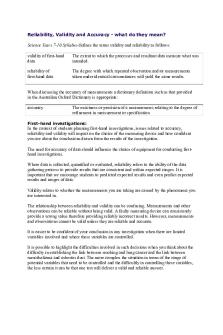Reliability, Validity and Threats to Validity PDF

| Title | Reliability, Validity and Threats to Validity |
|---|---|
| Author | Daniel Rein Santua |
| Course | Bs Psychology |
| Institution | Western Mindanao State University |
| Pages | 4 |
| File Size | 81.3 KB |
| File Type | |
| Total Downloads | 10 |
| Total Views | 147 |
Summary
Summary Notes about the definition of Reliability, Validity, and The threats to validity and how it is being describe in a methodology....
Description
RELIABILITY, VALIDITY AND THREATS TO VALIDITY
Reliability Is there consistency of test results? Validity Are you measuring what you say you are measuring? METHODOLOGY! Methodological Soundness 1. Anticipate potential threats to validity 2. Create procedures to eliminate or reduce threats
Types of Validity External validity: extent to which the results of the experiment can be generalized to people and settings that were not tested directly Internal validity: demonstrates that the IV was the sole cause for a change in the dependent variable – not other factors (threats) not related to the experiment.
Internal: demonstration of causality Was it what you did that made the DV change or was it something else??? Did “A” cause “B” 9 Evil Threats to Internal Validity
1. History Changes to DV due to: Historical Event An outside event or occurrence might have produced effects on the dependent variable 2. Maturation Changes to DV due to: Natural processes in subjects Happen as a function of time Not as a function of the experiment EX: aging, getting hungry, thirsty, more tired, etc. Ex: filling out a 500-item questionnaire… - get tired - Difficulty concentrating on answering items - Answers to items later in the test may be different from previous items, even if the items are similar. 3. Instrumentation Changes to DV due to: some aspect of a measurement instrument or scale, or some change in an observer or scorer Ex: an observer of children’s play behavior - More proficient over time affecting observation scores Ex: equipment - Measure RT becomes less and less exact due to mechanical breakdown
4. Testing Changes to DV due to: taking a pre-test which may affect scores on the post-test Ex: IQ test scores - 3-5 points higher the second time - Reading test 5. Regression to the Mean Changes to DV due to: participants are selected because their scores on a measure are extreme (either high or low)…they will tend to be less extreme on a second testing (scores regress toward the mean some)
Ex: Top 10% of a class – pretest shows they are above average….upon post test the change in score may not truly be due to the IV but due to the students score regressing toward the mean 6. Selection Changes to DV due to: groups being compared are not equivalent before manipulation begins Ex: experimental group may have higher intelligence than the control group 7. Mortality Changes to DV due to: Subjects dropping out . Dropping rate should be noted - you lose participants for Exp. or control groups for different reasons and/or you lose different numbers of participants in each group.
Ex: A clinical psychologist loses 40% of her Exp. Group but only 5% of the control group; the reason was because the “confrontation therapy” for the experimental group made clients too anxious to finish up treatment 8. Diffusion of IV Changes to DV due to: experimental groups communicating with each other – may give away the procedures …one group affects the other Ex: Dr. Q’s experiment…one student tells another student what the experiment was about later the other student goes into the experiment knowing what is expected 9. Sequence Effects Changes to DV due to: the order in which the subjects receive treatments (repeated measures..within subs)…carry over effects ( persistence of the effect of a treatment after it ends) Example: effect of alcohol on reaction time Threats to validity Subject effects: when people know they are being observed Changes to DV due to: demand characteristic cues given to subjects on how to behave in experiment (unintentional) Ex: placebo effect...
Similar Free PDFs

Reliability and Validity Notes
- 4 Pages

Reliability, validity and bias
- 1 Pages

Validity and reliability
- 2 Pages

Accuracy Reliability Validity
- 14 Pages
Popular Institutions
- Tinajero National High School - Annex
- Politeknik Caltex Riau
- Yokohama City University
- SGT University
- University of Al-Qadisiyah
- Divine Word College of Vigan
- Techniek College Rotterdam
- Universidade de Santiago
- Universiti Teknologi MARA Cawangan Johor Kampus Pasir Gudang
- Poltekkes Kemenkes Yogyakarta
- Baguio City National High School
- Colegio san marcos
- preparatoria uno
- Centro de Bachillerato Tecnológico Industrial y de Servicios No. 107
- Dalian Maritime University
- Quang Trung Secondary School
- Colegio Tecnológico en Informática
- Corporación Regional de Educación Superior
- Grupo CEDVA
- Dar Al Uloom University
- Centro de Estudios Preuniversitarios de la Universidad Nacional de Ingeniería
- 上智大学
- Aakash International School, Nuna Majara
- San Felipe Neri Catholic School
- Kang Chiao International School - New Taipei City
- Misamis Occidental National High School
- Institución Educativa Escuela Normal Juan Ladrilleros
- Kolehiyo ng Pantukan
- Batanes State College
- Instituto Continental
- Sekolah Menengah Kejuruan Kesehatan Kaltara (Tarakan)
- Colegio de La Inmaculada Concepcion - Cebu











